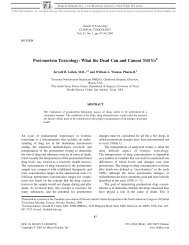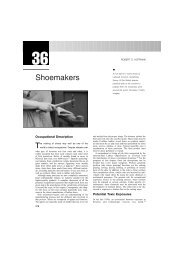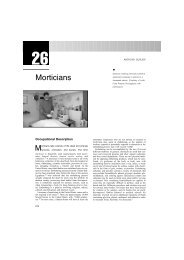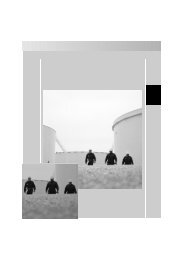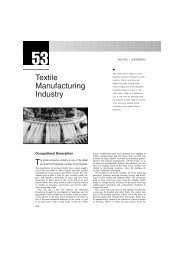9. Treatment of Amatoxin Poisoning-20 year retrospective analysis
9. Treatment of Amatoxin Poisoning-20 year retrospective analysis
9. Treatment of Amatoxin Poisoning-20 year retrospective analysis
You also want an ePaper? Increase the reach of your titles
YUMPU automatically turns print PDFs into web optimized ePapers that Google loves.
732<br />
damage. In a <strong>retrospective</strong> study <strong>of</strong> 175 cases with a<br />
mortality rate <strong>of</strong> 8.6%, [315] 131 patients were treated with<br />
silybin/benzylpenicillin combination (14 deaths) and 44<br />
patients received silybin alone (one death). However, the<br />
mean interval between mushroom ingestion and institution<br />
<strong>of</strong> silybin therapy as well as the severity <strong>of</strong> poisoning<br />
were not identical for the two therapeutic modes.<br />
Table 3 lists 74 amatoxin-poisoning cases (4.5% <strong>of</strong><br />
1632) treated with silybin as mono-chemotherapy and<br />
Tables 4–6 list 550 cases (33.7% <strong>of</strong> 1632) treated with<br />
silybin in combination with other drugs. Some authors<br />
suggested the combination <strong>of</strong> silybin plus benzylpenicillin<br />
to be more beneficial than other combinations.<br />
[18,69,224,337] Faulstich and Zilker thought that<br />
both drugs act as competitive inhibitors <strong>of</strong> the amatoxintransporting<br />
system and should not be used in<br />
combination [14] but did not consider the disparate effects<br />
<strong>of</strong> benzylpenicillin and silybin on a-Ama uptake<br />
reported by Kröncke et al. [279] In our survey, 379, 102,<br />
and 49 <strong>of</strong> 1632 amatoxin intoxicated patients received<br />
silybin/benzylpenicillin as bi-chemotherapy (23.2%,<br />
Table 4), tri-chemotherapy (6.3%, Table 4), and polychemotherapy<br />
(3%, Table 6), respectively.<br />
The initial dose <strong>of</strong> silybin dihemisuccinate is 5 mg/kg<br />
by IV infusion over 1 hour followed by <strong>20</strong> mg/kg/day by<br />
continuous infusion for six days until transaminase levels<br />
have normalized. [315] In the United States, silymarin is<br />
available only as a food supplement; at this time there is<br />
no active Investigational New Drug (IND) application<br />
for any component <strong>of</strong> the silymarin complex in the U.S.<br />
FDA. [231,315,338]<br />
No serious side effects have been observed with<br />
silybin [225] but nausea, epigastric discomfort, arthralgia,<br />
headaches, pruritus, and urticaria have been reported.<br />
Due to a lack <strong>of</strong> adequate clinical investigations, silybin<br />
is not administered to children under 12 <strong>year</strong>s <strong>of</strong> age,<br />
unless the benefits outweigh the risks. [315] Oral<br />
silymarin, Legalon w and b-cyclodextrin silybin have<br />
been recommended as an alternative to parenteral<br />
silybin. [133,339]<br />
Hepatoprotective activity <strong>of</strong> the Extractum Silybi<br />
fluidum (fluid extract) and “Silybochol” against rat liver<br />
damage caused by CCl 4 was recently shown. This<br />
preliminary finding suggests potential utility in clinical<br />
trials <strong>of</strong> the bio-active substances from S. marianum fruit<br />
powder, fluid extract, and fatty oil. [340]<br />
Thioctic Acid<br />
Mechanistic studies on thioctic acid (a-lipoic acid;<br />
1,2-dithiolane-3-pentanoic acid) suggest a rationale for<br />
MARCEL DEKKER, INC. 270 MADISON AVENUE NEW YORK, NY 10016<br />
©<strong>20</strong>02 Marcel Dekker, Inc. All rights reserved. This material may not be used or reproduced in any form without the express written permission <strong>of</strong> Marcel Dekker, Inc.<br />
Enjalbert et al.<br />
potential benefit in amatoxin hepatotoxicity. Acting as a<br />
free radical scavenger, it might prevent lipid peroxidation<br />
<strong>of</strong> the cell membrane by dissociating the hydrogen<br />
ion on the sulfhydryl groups <strong>of</strong> dihydrothioctic acid, its<br />
main metabolite. [354] Due to the antioxidant activity <strong>of</strong><br />
both oxidized and reduced forms, affecting in vitro<br />
cellular metabolic processes, thioctic acid is capable <strong>of</strong><br />
regenerating directly vitamin C and indirectly vitamin E,<br />
as well as influencing the increase <strong>of</strong> intracellular<br />
glutathione content. [355,356] Thioctic acid has a therapeutic<br />
potential in the treatment <strong>of</strong> hepatic diseases<br />
induced by chemical agents in animal models as<br />
reviewed by Bustamante et al. [356]<br />
It was introduced for the treatment <strong>of</strong> amatoxin<br />
poisoning in the Czech Republic by Kubicka in 196<strong>9.</strong> [341]<br />
The successful use <strong>of</strong> a-lipoic acid was also reported<br />
from Italy [342,343] and then reviewed in the Eastern<br />
European literature. [344,345] In the United States, the first<br />
use <strong>of</strong> thioctic acid was described in 1972 in New Jersey<br />
for A. verna intoxication with apparently beneficial<br />
result. [346] The cause–effect relationship between<br />
thioctic acid administration and clinical improvement<br />
in amatoxin poisoning is not clearly established and<br />
opinion concerning efficacy is divergent. [347 – 351] Early<br />
enthusiasm in the United States waned as investigations<br />
<strong>of</strong> thioctic acid carried out in Amanita poisoned mice and<br />
dogs reported either a severe glucose imbalance [352] or<br />
ineffectiveness <strong>of</strong> the drug. [353] A controlled clinical trial<br />
was never conducted and there were too few patients<br />
enrolled in the IND study to support a claim <strong>of</strong> efficacy.<br />
This drug is unavailable for human use in the United<br />
States. Multiple authors discourage its clinical<br />
use. [74,352,357 – 359] According to Floersheim et al. [298]<br />
and Floersheim [360] the administration <strong>of</strong> thioctic acid is<br />
<strong>of</strong>ten associated with a fatal outcome and it should be<br />
removed from the therapeutic protocol. [231] Other<br />
authors support thioctic acid trials in amatoxin poisoning<br />
until its efficacy can be confirmed or refuted. [23,361,362]<br />
Given the experimental findings <strong>of</strong> hypoglycemia as a<br />
major side effect <strong>of</strong> thioctic acid, [348,352] the drug should<br />
beadministeredwithasustainedIVdrip<strong>of</strong>glucose. [349,363]<br />
In clinical use, thioctic acid was combined with glucose<br />
in IV infusions at doses <strong>of</strong> (i) 300 mg/kg/day in four<br />
divided doses and then 600 mg/kg/day [73,361] and (ii)<br />
50–150 mg/kg/day. [364] Allergic skin reactions have<br />
been reported. [355] Because it is sensitive to light and<br />
heat, bottles and infusion lines containing the solution<br />
must be wrapped in aluminum foil. [231,347,349]<br />
In this <strong>20</strong>-<strong>year</strong> case survey beginning in the 1980s,<br />
thioctic acid was used in 8 <strong>of</strong> 1632 amatoxin poisonings<br />
(0.5%, Table 3) as single chemotherapy and in 442 <strong>of</strong>




